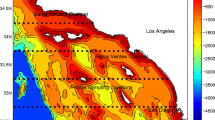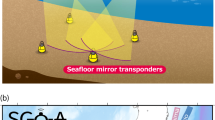Abstract
It is essential to acquire sound speed profiles (SSPs) in high-precision spatiotemporal resolution for undersea acoustic activities. However, conventional observation methods cannot obtain high-resolution SSPs. Besides, SSPs are complex and changeable in time and space, especially in coastal areas. We proposed a new space-time multigrid three-dimensional variational method with weak constraint term (referred to as STC-MG3DVar) to construct high-precision spatiotemporal resolution SSPs in coastal areas, in which sound velocity is defined as the analytical variable, and the Chen-Millero sound velocity empirical formula is introduced as a weak constraint term into the cost function of the STC-MG3DVar. The spatiotemporal correlation of sound velocity observations is taken into account in the STC-MG3DVar method, and the multi-scale information of sound velocity observations from long waves to short waves can be successively extracted. The weak constraint term can optimize sound velocity by the physical relationship between sound velocity and temperature-salinity to obtain more reasonable and accurate SSPs. To verify the accuracy of the STC-MG3DVar, SSPs observations and CTD observations (temperature observations, salinity observations) are obtained from field experiments in the northern coastal area of the Shandong Peninsula. The average root mean square error (RMSE) of the STC-MG3DVar-constructed SSPs is 0.132 m/s, and the STC-MG3DVar method can improve the SSPs construction accuracy over the space-time multigrid 3DVar without weak constraint term (ST-MG3DVar) by 10.14% and over the spatial multigrid 3DVar with weak constraint term (SC-MG3DVar) by 44.19%. With the advantage of the constraint term and the spatiotemporal correlation information, the proposed STC-MG3DVar method works better than the ST-MG3DVar and the SC-MG3DVar in constructing high-precision spatiotemporal resolution SSPs.
Similar content being viewed by others
Data Availability Statement
The datasets generated and/or analyzed during the current study are not publicly available due to state policy restrictions, but are available from the corresponding author on reasonable request.
References
Bannister R N. 2017. A review of operational methods of variational and ensemble-variational data assimilation. Quarterly Journal of the Royal Meteorological Society, 143(703): 607–633, https://doi.org/10.1002/qj.2982.
Bocquet M, Pires C A, Wu L. 2010. Beyond Gaussian statistical modeling in geophysical data assimilation. Monthly Weather Review, 138(8): 2997–3023, https://doi.org/10.1175/2010MWR3164.1.
Carrassi A, Bocquet M, Bertino L et al. 2018. Data assimilation in the geosciences: an overview of methods, issues, and perspectives. WIREs Climate Change, 9(5): e535, https://doi.org/10.1002/wcc.535.
Carrier M J, Ngodock H, Smith S et al. 2014. Impact of assimilating ocean velocity observations inferred from Lagrangian drifter data using the NCOM-4DVAR. Monthly Weather Review, 142(4): 1509–1524, https://doi.org/10.1175/MWR-D-13-00236.1.
Chen C T, Millero F J. 1977. Speed of sound in seawater at high pressures. The Journal of the Acoustical Society of America, 62(5): 1129–1135, https://doi.org/10.1121/1.381646.
Chen C, Yan F G, Gao Y et al. 2020. Improving reconstruction of sound speed profiles using a self-organizing map method with multi-source observations. Remote Sensing Letters, 11(6): 572–580, https://doi.org/10.1080/2150704X.2020.1742940.
Church I W. 2020. Multibeam sonar Ray-Tracing uncertainty evaluation from a hydrodynamic model in a highly stratified estuary. Marine Geodesy, 43(4): 359–375, https://doi.org/10.1080/01490419.2020.1717695.
Derber J, Rosati A. 1989. A global oceanic data assimilation system. Journal of Physical Oceanography, 19(9): 1333–1347, https://doi.org/10.1175/1520-0485(1989)019<1333:AGODAS>2.0.CO;2.
Desroziers G, Camino J T, Berre L. 2014. 4DEnVar: link with 4D state formulation of variational assimilation and different possible implementations. Quarterly Journal of the Royal Meteorological Society, 140(684): 2097–2110, https://doi.org/10.1002/qj.2325.
Didier C, Jaouad E, Gaspard G et al. 2019. Real-time correction of sound refraction errors in bathymetric measurements using multiswath multibeam echosounder. In: OCEANS 2019. IEEE, Marseille, France. p.1–7.
Edwards C A, Moore A M, Hoteit I et al. 2015. Regional ocean data assimilation. Annual Review of Marine Science, 7: 21–42, https://doi.org/10.1146/annurev-marine-010814-015821.
Evensen G. 2003. The Ensemble Kalman Filter: theoretical formulation and practical implementation. Ocean Dynamics, 53(4): 343–367, https://doi.org/10.1007/s10236-003-0036-9.
Fox D N, Teague W J, Barron C N et al. 2002. The modular ocean data assimilation system (MODAS). Journal of Atmospheric and Oceanic Technology, 19(2): 240–252, https://doi.org/10.1175/1520-0426(2002)019<0240:TMODAS>2.0.CO;2.
Fu W W. 2013. Estimating the volume and salt transports during a major inflow event in the Baltic Sea with the reanalysis of the hydrography based on 3DVAR. Journal of Geophysical Research: Oceans, 118(6): 3103–3113, https://doi.org/10.1002/jgrc.20238.
Fu W, She J, Dobrynin M. 2012. A 20-year reanalysis experiment in the Baltic Sea using three-dimensional variational (3DVAR) method. Ocean Science, 8(5): 827–844, https://doi.org/10.5194/os-8-827-2012.
Furlong A, Beanlands B, Chin-Yee M. 1997. Moving vessel profiler (MVP) real time near vertical data profiles at 12 knots. In: Oceans’ 97. MTS/IEEE Conference Proceedings. IEEE, Halifax, NS, Canada. p.229–234.
Hayden C M, James Purser R. 1995. Recursive filter objective analysis of meteorological fields: applications to NESDIS operational processing. Journal of Applied Meteorology, 34(1): 3–15.
Houtekamer P L, Zhang F Q. 2016. Review of the ensemble Kalman filter for atmospheric data assimilation. Monthly Weather Review, 144(12): 4489–4532, https://doi.org/10.1175/MWR-D-15-0440.1.
Jamshidi S, Abu Bakar N B. 2011. The sound speed in southern deepwater zone of the Caspian Sea, off Anzali Port. Acoustical Physics, 57(2): 180–191, https://doi.org/10.1134/S1063771011010076.
Keppenne C L, Rienecker M M, Kurkowski N P et al. 2005. Ensemble Kalman filter assimilation of temperature and altimeter data with bias correction and application to seasonal prediction. Nonlinear Processes in Geophysics, 12(4): 491–503, https://doi.org/10.5194/npg-12-491-2005.
Li W, Xie Y F, Deng S M et al. 2010. Application of the multigrid method to the two-dimensional Doppler radar radial velocity data assimilation. Journal of Atmospheric and Oceanic Technology, 27(2): 319–332, https://doi.org/10.1175/2009JTECHA1271.1.
Li W, Xie Y F, Han G J. 2013. A theoretical study of the multigrid three-dimensional variational data assimilation scheme using a simple bilinear interpolation algorithm. Acta Oceanologica Sinica, 32(3): 80–87, https://doi.org/10.1007/s13131-013-0292-6.
Li W, Xie Y F, He Z J et al. 2008. Application of the multigrid data assimilation scheme to the China Seas’ temperature forecast. Journal of Atmospheric and Oceanic Technology, 25(11): 2106–2116, https://doi.org/10.1175/2008JTECHO510.1.
Liang K Z, Li W, Han G J et al. 2021. An analytical four-dimensional ensemble-variational data assimilation scheme. Journal of Advances in Modeling Earth Systems, 13(1): e2020MS002314, https://doi.org/10.1029/2020MS002314.
Liu C S, Xiao Q N. 2013. An Ensemble-Based Four-Dimensional variational data assimilation scheme. Part III: antarctic applications with advanced research WRF using real data. Monthly Weather Review, 141(8): 2721–2739, https://doi.org/10.1175/MWR-D-12-00130.1.
Liu C S, Xue M. 2016. Relationships among Four-Dimensional hybrid ensemble-variational data assimilation algorithms with full and approximate ensemble covariance localization. Monthly Weather Review, 144(2): 591–606, https://doi.org/10.1175/MWR-D-15-0203.1.
Mamayev O I. 1975. Temperature-Salinity Analysis of World Ocean Waters. Elsevier, Amsterdam.
Mu M. 2013. Methods, current status, and prospect of targeted observation. Science China Earth Sciences, 56(12): 1997–2005, https://doi.org/10.1007/s11430-013-4727-x.
Ngodock H, Carrier M. 2014. A 4DVAR system for the navy coastal ocean model. Part I: system description and assimilation of synthetic observations in Monterey Bay. Monthly Weather Review, 142(6): 2085–2107, https://doi.org/10.1175/MWR-D-13-00221.1.
Powell B S, Arango H G, Moore A M et al. 2008a. 4DVAR data assimilation in the Intra-Americas Sea with the Regional Ocean Modeling System (ROMS). Ocean Modelling, 25(3–4): 173–188, https://doi.org/10.1016/j.ocemod.2008.08.002.
Powell B S, Arango H G, Moore A M et al. 2008b. 4DVAR data assimilation in the Intra-Americas Sea with the Regional Ocean Modeling System (ROMS). Ocean Modelling, 23(3–4): 130–145, https://doi.org/10.1016/j.ocemod.2008.04.008.
Shinoda T. 2012. Observation of first and second baroclinic mode Yanai waves in the ocean. Quarterly Journal of the Royal Meteorological Society, 138(665): 1018–1024, https://doi.org/10.1002/qj.968.
Shu Y Q, Zhu J, Wang D X et al. 2011. Assimilating remote sensing and in situ observations into a coastal model of northern South China Sea using ensemble Kalman filter. Continental Shelf Research, 31(S6): S24–S36, https://doi.org/10.1016/j.csr.2011.01.017.
Wang J B, Flierl G R, LaCasce J H et al. 2013. Reconstructing the ocean’s interior from surface data. Journal of Physical Oceanography, 43(8): 1611–1626, https://doi.org/10.1175/JPO-D-12-0204.1.
Wunsch C. 1997. The vertical partition of oceanic horizontal kinetic energy. Journal of Physical Oceanography, 27(8): 1770–1794, https://doi.org/10.1175/1520-0485(1997)027<1770:TVPOOH>2.0.CO;2.
Xie Y F, Koch S E, McGinley J A et al. 2005. A sequential variational analysis approach for mesoscale data assimilation. In: 21st Conference on Weather Analysis and Forecasting/17th Conference on Numerical Weather Prediction. American Meteorological Society, Washington, DC, USA. (Available online at http://ams.confex.com/ams/pdfpapers/93468.pdf).
Zhang K, Mu M, Wang Q. 2020. Increasingly important role of numerical modeling in oceanic observation design strategy: a review. Science China Earth Sciences, 63(11): 1678–1690, https://doi.org/10.1007/s11430-020-9674-6.
Acknowledgment
The authors gratefully acknowledge the anonymous reviewers for their constructive comments.
Author information
Authors and Affiliations
Corresponding authors
Additional information
Supported by the National Natural Science Foundation of China (No. 41876014) and the Open Project of Tianjin Key Laboratory of Oceanic Meteorology (No. 2020TKLOMYB04)
Rights and permissions
About this article
Cite this article
Hou, G., Zhai, J., Shao, Q. et al. Sound speed profiles in high spatiotemporal resolution using multigrid three-dimensional variational method: a coastal experiment off northern Shandong Peninsula. J. Ocean. Limnol. 41, 57–71 (2023). https://doi.org/10.1007/s00343-022-1295-y
Received:
Accepted:
Published:
Issue Date:
DOI: https://doi.org/10.1007/s00343-022-1295-y




